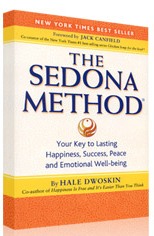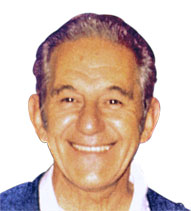Sedona Method Review – Letting Go / Releasing

The Sedona Method is all about letting go of, or “releasing” emotions.
While simple, the technique can be beautiful and very profound. It does not try to make you push away emotion, which is really a form of suppression or avoidance.
It begins from a place of welcoming, fully accepting whatever you are experiencing. This really opens things up, and we begin seeing what is going on at a deeper level.
From this place we can “let go” of our grip, our grasping, personal agenda and wanting to control. This has a very counter-intuitive effect: one of liberation, and usually an increase in clarity, energy and inspiration.
It is the about getting in touch with a natural, more powerful way of processing emotions than most of us have been conditioned to do.
“The Method” is a deceptively simple process – one of those things you might say “that’s it?” when someone describes it to you. There is power in the simplicity though, and it can get you back in touch with a more natural and healthy way to relate to your experience.
Once you get a grasp on this process, it can be applied to essentially any subject or area of life. There are a lot of very useful tools and specific processes developed to deepen and focus the technique that you can then explore.
There is a lot of information and personal experience in the rest of the article.
However, you might already be interested, and the full Sedona Method Book (which teaches everything) is often available for literally a dollar or two.
So here is a link for that:

Check out the book for super cheap here
Why Even Bother with “Letting Go”?
Sometimes the idea of letting go sounds apathetic, or defeated, but that is really not what is at work here. The Sedona Method is definitely one of the simpler yet more effective tools I’ve come across, and I don’t mean this to sound like a commercial. It just happens to be a very important foundation for me, as it had to do with HOW I process what I experience.
It applies to, and enhances, just about anything one might be doing in the personal development arena. It is something that can evolve into a way of being more than just a technique.
Almost any physical, psychological, or “spiritual” work brings up a lot of emotion and energy. You know what else does? About 10,000 things that happen every day. Whatever your default setting is for how you process this energy – whether you resist it, get agitated by it, get consumed by it, deny it, and so on, plays an enormous role in both your physical and mental state.
That was certainly a good enough reason for me to give it a chance.
Now, most of what follows is based largely on my experience with releasing / the Sedona Method. For me, some of the “official” sources like their home page focus a bit much on “make more money” and self help hype side of things – as opposed to the simplicity, power and practicality of what this really is.
My First Experience with Releasing
My very first experience with Sedona Method was interesting to say the least, and I got to try it on something very practical – a physical pain. I was not so into “working on my core beliefs” or any of that (what I would call) BS at the time.
I work with my hands for a living, and one night after a long day, one of my hands was hurting. Really hurting.. as in, “I’m not sure I can work tomorrow” hurting, which I’d never felt before. I was on my way to an event where, at that time, my entire self-esteem would be derived from how well my work was received. Also, no hand usage = not making money for me, so there were just a few things going on in my head.
I had just downloaded a free Sedona Method MP3 and put it into my iPod that night. It was led by Hale Dwoskin, the figurehead of the Sedona Method, explaining and going through the process.
The first step walked through welcoming the experience. This had never been an option with pain before. My mind was saying “you can’t have this, this is bad, this can’t be happening. Pretend this isn’t there. You’ll be fine. It’s fine, right?”
For the first time I stopped, and just welcomed it fully. Things started moving.. it was doing it’s thing. What it naturally knew how to do when the energy was not being blocked by enormous internal resistance to it.
Then there was the process of identifying the “want” behind this.. they say that any thought or desire is coming from a few basic wants: security (safety, survival, etc) approval (wanting love/attention), control. I definitely wanted to control the pain. To get rid of it. That was what to “let go” of, that feeling of wanting. You can’t control everything that is happening, but this was showing me that you CAN make choices to control how you are reacting to them.
The analogy for letting go, which was walked through, was dropping a pen. You have to be holding on to a pen for it to stay in your hand. THAT actually requires effort, but if you do it long enough, it feels natural and automatic.
The Sedona Method Pen Demo by Hale
To let go is to just stop holding, it’s sort of a non-doing. By refusing to let the pain do what it needed to do and holding all the garbage in my head about it, I was creating extra tension there.
It felt a lot better.. real fast. I was able to use my hands right away. I was a believer. This was concrete.. this wasn’t me “feeling better about myself” with no practical applications. I also became better than everyone in the place, was offered a ton of high paying work and found my soul mate immediately. (OK, that last sentence was making fun of the testimonials most people leave for these kinds of things.) My arm feeling better was good enough.
The thing about the Sedona Method though is that it really works it’s magic when applied to your usual habit of thought.. the emotions you are feeling on a day to day basis.
How To: The Sedona Method Questions
It is helpful at first to get in touch with the context here, and to realize this is something you have always been able to do. As a child your emotions would naturally vacillate from one moment to the next. You would experience sadness when you were deprived of your mothers comfort and attention. Once you were being held in her arms, your sadness would be quickly forgotten.
When we move from childhood to adulthood we lose the ability to allow our emotions to fade away. Instead we retain the negative emotion beyond the time when it has served its particular purpose. We rethink over these hurtful events and continue to re-experience that negative emotion.
The Sedona method teaches us how to release those unwanted or painful experiences. The best way to begin the process is by asking yourself a series of four questions. With all four of these questions there is no wrong or right answer. Allow yourself to answer with whatever comes first and experience the questions naturally.
Can you welcome and accept this emotion right now?
When people ask themselves this question the emotion is usually so deeply felt that it is impossible to ignore. However if your first inclination is to refuse the emotion then that is perfectly fine as well.
Sometimes we are unable to specifically identify the emotion. That is perfectly ok as well. Simply label it “that uncomfortable feeling” for now. It is more important that you experience the emotion.
Try to allow the emotion to become fully present. When we try to ignore or suppress an emotion, we only feed it and give it more power. For example if you are feeling nervous you might experience this has a tightening in your stomach or a quickening of your breathing.
Could I let this go?
Pay close attention to this sentence. Notice that you are not being given a command but instead asking yourself a question. That question is whether it is possible for you to let this emotion go.
To make it easier to let the emotion go, do not think about the emotion as a concept such as stress, anger or envy. Instead feel the physical sensations that come with that emotion. It is easier to accept that you can release those physical sensations than it is the concept itself.
We all have the capacity to release emotions. By asking this question you empower yourself to make that choice.
Would I let this go?
When we ask ourselves this question, we are questioning whether we have the desire to release this emotion. This is not a question about a capability. We are not asking ourselves whether we are capable of wanting to let this emotion go, only if we want to.
When will you let this go?
One of the “tricks” with this question is to see it as an invitation to do it now. Why not try it now? However, that does not mean it is a correct answer.
The mind-answer to this question will differ for everyone. Perhaps you feel something that says you could let this emotion go a week or a month from now. Maybe you believe it will take you a year before you can release this emotion. Or maybe your immediate answer is never. The point is to be direct and honest.
If you have answered that you can release this emotion at some point in the future, then you have shown to yourself two important things. Firstly you understand that you have the capacity to choose to release the emotion. And secondly you have implicitly stated that you have the desire to let the emotion go.
Repeating the process
Often you will find that you have released your grip on the emotion by the time you have answered the last question. You may have released the emotion even if you have answered no to the second and third question.
At other times though asking yourself these questions once will not be sufficient. Repeat the questions again in the order they are laid out, until you feel able to let the negative emotion go.
The Origin of the Method
“The method” is based on the teachings of an American master named Lester Levenson. A well respected physicist who seemingly had everything one would need to be happy, Lester was in emotional turmoil that spiraled into depression and massive illness. Literally sentenced to death by his doctors, he was given an extremely short expectancy and told something as small as taking the stairs could kill him.
With essentially nothing left, Lester began a process of deep self inquiry, including “correcting” his past memories by changing his feelings of wanting and dissatisfaction to those of love. One of his most valuable discoveries was that he realized that the times in his life he was happiest was when giving love, rather than receiving rewards or affection.
The result of Levenson’s inquiry was such that he lived another 4 decades and took his exploration of consciousness to levels of mastery – much of his teachings delve into non-duality and he developed Siddhi powers as well, effortlessly creating things he desired (including huge amounts of money, which he basically gave all away and moved to Sedona). There is another article on this site but it is most powerful and inspiring to hear his story in his own words.
Lester spent the majority of his life afterwards either in peaceful separation from the busy world, or giving talks and helping others explore his process. It seems his students and partners essentially broke down a lot of his principles and created elements of the process known as the “Sedona Method.” I have not heard any recordings of Lester actually doing “the method” but rather teaching concepts, some very advanced and far beyond self-help or ego identification, but he regularly emphasizes releasing the basic “wants” which is the core of the process.
An Important Distinction
Many people hear Lester’s story and get excited about this technique that “cured him.” The products around the method are also often heavily marketed around themes like “achieve great health, wealth, relationships” and so on.
Going in with the mindset can heavily dilute the true depth of his process. Lester was expecting that he was going to die, and was doing deep, honest, intense spiritual inquiry with no agenda. He was not doing a technique that he thought would cure him – he was well past all of that. I believe one gets the most out of this method by coming from a place of welcoming what is and exploring deeply and honestly. If you go in armed to “fix all of your problems” you are essentially already set up to not let things go.
This is why I recommend meditation and foundational practices like “Just Allow It” to get you oriented to this position, before or in tandem with things like the Sedona Method which are easy, especially with the marketing, to be approached as “techniques to fix your life.” It really is a powerful method worth exploring, which you can do with considerable depth for basically nothing (the book costs peanuts), but like anything your mindset can save you a lot of time and pitfalls, so take that for what it is worth.
Sedona Method Materials
 One thing I like about the Sedona Method is that the book lays it all out. It’s not expensive and it’s paper back. It’s not a teaser to get you to buy more Sedona Method stuff – I know how frustrating that is – you really get a complete picture from it and essentially a lifetimes worth of value out of it.
One thing I like about the Sedona Method is that the book lays it all out. It’s not expensive and it’s paper back. It’s not a teaser to get you to buy more Sedona Method stuff – I know how frustrating that is – you really get a complete picture from it and essentially a lifetimes worth of value out of it.
The reason for the recordings and so many different variations is that, for one, it can be a lot easier to sit and be guided through it then be reading, stopping, reading the process, etc. You can get a lot of meat out of going through the process looking at different issues (money, sex etc) from different perspectives. You’d be surprised how any one of those, you could dig into for over an hour and just scratch the surface, hence the amount of material out there. Sedona Method junkees often can’t get enough, because every new angle usually shows something new to explore and again, most importantly, almost always yields some type of RESULT (here’s the catch: just feeling more peaceful or realizing something wasn’t worth worrying about counts as a result).
You can get the book for just a few dollars (see below) so that if it sounds interesting to you, you might as well check it out.


